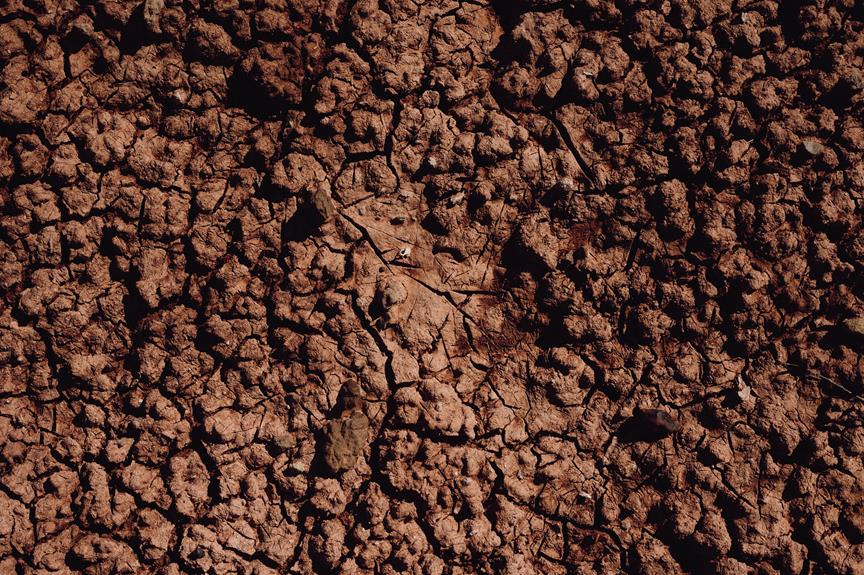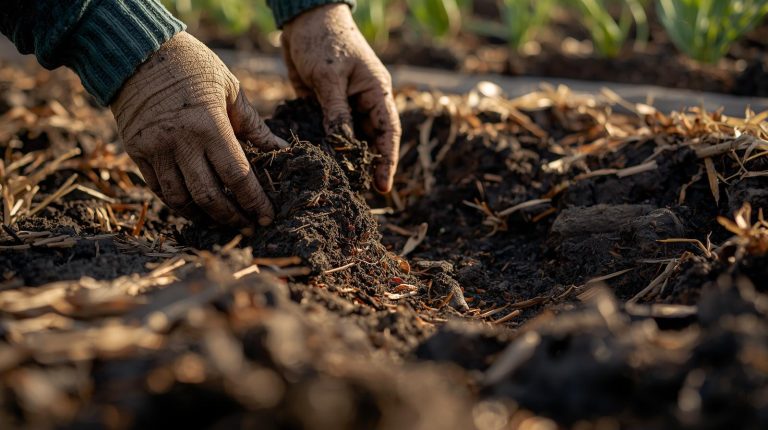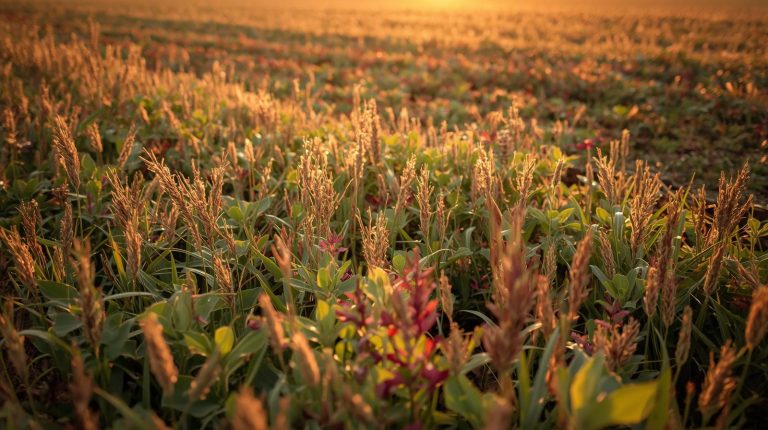Hey there, fellow veggie garden enthusiasts! Have you ever wondered how to give your plants the best possible soil to thrive in? Well, you’re in luck because we’ve got the inside scoop on the 6 best soil enrichment techniques for veggie gardens.
Now, here’s something you probably didn’t know – did you know that there are specific methods to enrich your soil that can significantly boost the health and productivity of your beloved veggies? It’s true!
From composting to cover cropping, crop rotation to vermicomposting, green manure to mulching, we’ve got you covered. By implementing these techniques, you’ll not only create a thriving garden but also a sense of belonging in the veggie gardening community.
So, let’s get our hands dirty and dive into these soil enrichment techniques together!
Composting
To improve the fertility and nutrient content of our soil, we can start by incorporating composting into our veggie gardens. Composting offers numerous benefits for our plants and the overall health of our garden. Firstly, it enriches the soil by providing essential organic matter, such as decomposed leaves, kitchen scraps, and yard waste. This organic matter improves soil structure, allowing for better water retention and aeration, which in turn promotes healthy root development.
Secondly, composting boosts soil fertility by introducing beneficial microorganisms, such as bacteria and fungi, that break down organic matter and release nutrients for plant uptake. Lastly, composting helps reduce waste by diverting organic material from landfills and turning it into a valuable resource for our gardens.
There are various composting methods available, including traditional backyard composting, vermicomposting with worms, and even composting in enclosed bins or tumblers for smaller spaces. By incorporating composting into our veggie gardens, we can create a sustainable and nutrient-rich environment for our plants to thrive.
Cover Cropping
One effective soil enrichment techniques and nutrient content enhancement in our veggie gardens is by incorporating cover cropping. Cover crops are plants that are grown specifically to benefit the soil, rather than for harvest. They offer a range of benefits, such as reducing soil erosion, suppressing weeds, improving soil structure, and increasing organic matter.
When selecting a cover crop, it’s important to consider the specific needs of your garden. For example, legumes like clover and vetch are excellent choices as they fix nitrogen in the soil. Grasses such as rye and barley can help with weed suppression and add organic matter. Brassicas like mustard and radish can break up compacted soil.
Crop Rotation
For the practice of crop rotation, we use a specific sequence of planting different crops in order to improve soil health and maximize vegetable yields. Crop rotation offers numerous benefits for veggie gardens.
Firstly, it helps prevent the buildup of pests and diseases that target specific crops. By rotating crops, we disrupt the life cycles of these pests and reduce the need for chemical interventions.
Secondly, different crops have different nutrient requirements. By rotating crops, we can ensure that the soil is replenished with the nutrients that each crop needs. For example, legumes like beans and peas fix nitrogen in the soil, benefiting subsequent crops.
Lastly, certain crops, such as corn and potatoes, are particularly susceptible to soil-borne diseases. By rotating these crops, we can minimize the risk of disease outbreaks and maintain healthy soil.
Some of the best crops for crop rotation include legumes, brassicas, and alliums. Legumes replenish nitrogen levels in the soil, brassicas help control pests, and alliums deter pests with their strong smell.
Vermicomposting
Vermicomposting, also known as worm composting, is a fantastic way to enrich the soil in our vegetable gardens. By using earthworms to break down organic materials, such as kitchen scraps and yard waste, we can create nutrient-rich compost that improves soil structure and fertility.
Setting up a DIY vermicomposting system is relatively simple and requires a container, bedding material, and a population of redworms.
Benefits of Vermiculture
To enhance the fertility and nutrient content of our veggie gardens, we can employ the highly effective technique of vermicomposting. Vermicomposting, or vermiculture, is the process of using earthworms to break down organic waste materials into nutrient-rich compost.
This method offers numerous benefits for our gardens and the environment. Firstly, vermicomposting produces nutrient-rich soil that’s essential for healthy plant growth. The worms break down the organic matter, converting it into a form that plants can easily absorb. This leads to improved soil structure, increased water retention, and enhanced nutrient availability.
Secondly, vermicomposting is a sustainable gardening practice. By diverting organic waste from landfills and turning it into valuable compost, we reduce greenhouse gas emissions and promote a circular economy. Vermiculture allows us to create a self-sustaining system where our garden thrives and our ecological footprint is minimized.
DIY Vermicomposting Setup
We frequently set up our own DIY vermicomposting system to enrich the soil in our veggie gardens. Vermicomposting, also known as worm composting, offers numerous benefits for both the environment and our plants. Here’s how we do it:
- First, we choose a suitable container, such as a plastic bin with a lid, to house our worm composting system.
- Next, we create a bedding material using a combination of shredded newspaper, cardboard, and coconut coir. This provides a cozy environment for the worms.
- We then introduce red worms, also known as Eisenia fetida, to the bedding. These worms are excellent decomposers and thrive in the composting process.
- Finally, we add kitchen scraps, such as fruit and vegetable peels, coffee grounds, and eggshells, to the bin. The worms will consume the organic waste and convert it into nutrient-rich vermicompost.
Green Manure
Green manure is one of excellent soil enrichment techniques in vegetable gardens. By planting specific cover crops and then incorporating them into the soil, we can improve fertility, increase organic matter, and suppress weeds.
There are different types of green manure, such as legumes, grasses, and brassicas, each offering unique benefits to the soil.
Benefits of Green Manure
One of the most effective ways to enhance the fertility of our veggie gardens is by utilizing the benefits offered by the practice of incorporating green manure into our soil.
Green manure refers to the practice of growing specific crops, such as clover or alfalfa, and then incorporating them into the soil while they’re still green. This technique provides a multitude of benefits for our gardens:
- Nutrient-rich soil additives: Green manure crops are known to accumulate essential nutrients from the air and soil, such as nitrogen and phosphorus. When these crops are incorporated into the soil, they release these nutrients, enriching the soil and providing a natural source of nourishment for our veggies.
- Sustainable gardening practices: By using green manure, we can reduce our reliance on synthetic fertilizers and chemical additives. This promotes a more sustainable gardening approach, minimizing the negative impact on the environment and creating a healthier ecosystem for our plants.
- Improved soil structure: The incorporation of green manure helps to improve soil structure by increasing its organic matter content. This leads to better water retention, aeration, and overall soil health, providing an ideal environment for our veggies to thrive.
Types of Green Manure
To begin exploring the different types of green manure, let’s first understand their role in enriching the soil of veggie gardens.
Green manure refers to the practice of planting specific crops that are grown to be turned into the soil while they’re still green and actively growing. This technique is used to improve the soil’s fertility and structure, as well as suppress weeds and pests.
There are several types of green manure alternatives that gardeners can choose from, including legumes like clover and vetch, grasses like rye and oats, and brassicas like mustard and radish. Each type offers unique benefits for flower gardens, such as fixing nitrogen, adding organic matter, and increasing soil moisture retention.
Mulching
We often incorporate mulching into our veggie gardens to improve soil quality and retain moisture. Mulching offers numerous benefits that contribute to the overall health and productivity of our plants.
Some key advantages of mulching include:
- Weed suppression: By covering the soil with a layer of organic material, such as straw or wood chips, mulching helps prevent weeds from germinating and competing with our vegetables for nutrients and water.
- Moisture retention: Mulch acts as a protective barrier, reducing evaporation and keeping the soil moist for longer periods. This is particularly important during hot and dry weather conditions.
- Temperature regulation: Mulch helps to insulate the soil, keeping it cooler in the summer and warmer in the winter, creating a more stable environment for our veggies to thrive.
When it comes to mulching techniques, we prefer using organic materials like straw, grass clippings, or compost. These materials are readily available, easy to apply, and enrich the soil as they break down over time.
We spread a layer of mulch around our plants, making sure to leave a small gap around the stems to prevent rot. Regularly replenishing the mulch layer is essential to maintain its effectiveness throughout the growing season.
Conclusion
In conclusion, the soil enrichment techniques mentioned above are like the secret ingredients that make a dish truly extraordinary. Just as a pinch of salt enhances the flavor, composting, cover cropping, crop rotation, vermicomposting, green manure, and mulching work together to create a rich and fertile soil that nourishes our vegetable gardens.
By implementing these techniques, we can unlock the full potential of our gardens, yielding bountiful harvests and vibrant, healthy plants.
So let’s dig in and start enriching our soil for a flourishing veggie paradise.




